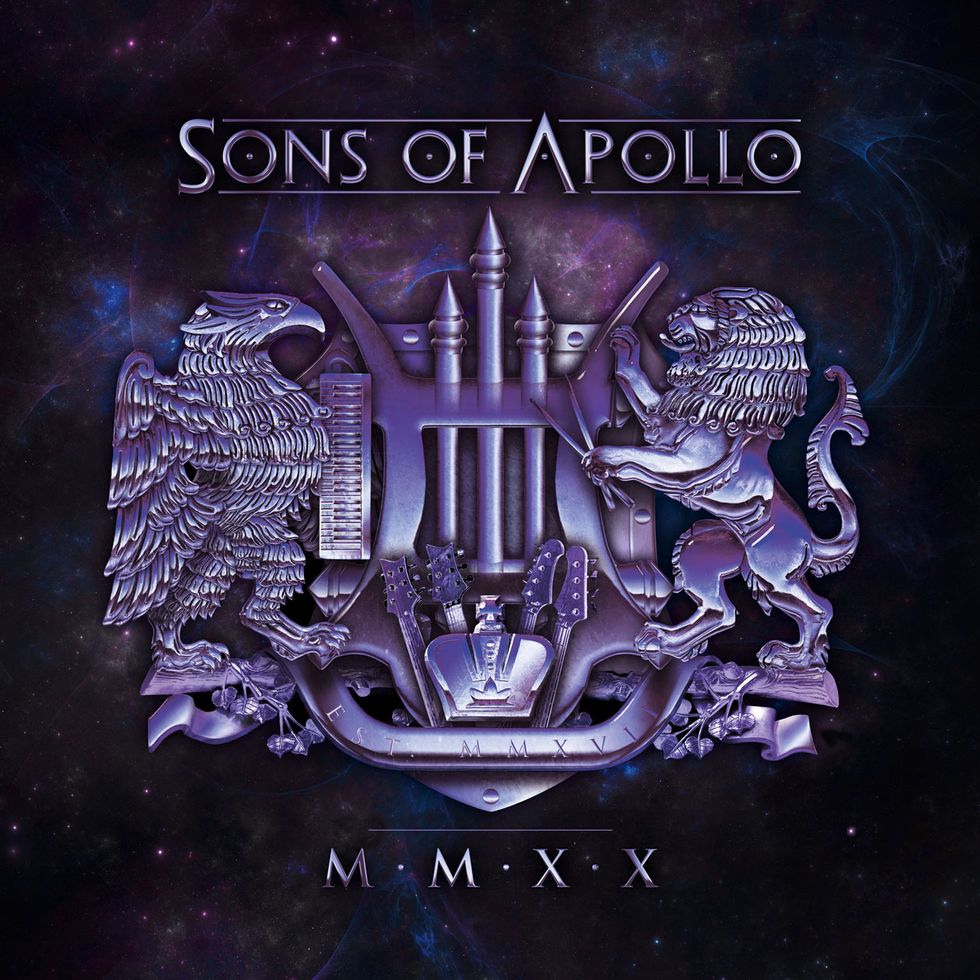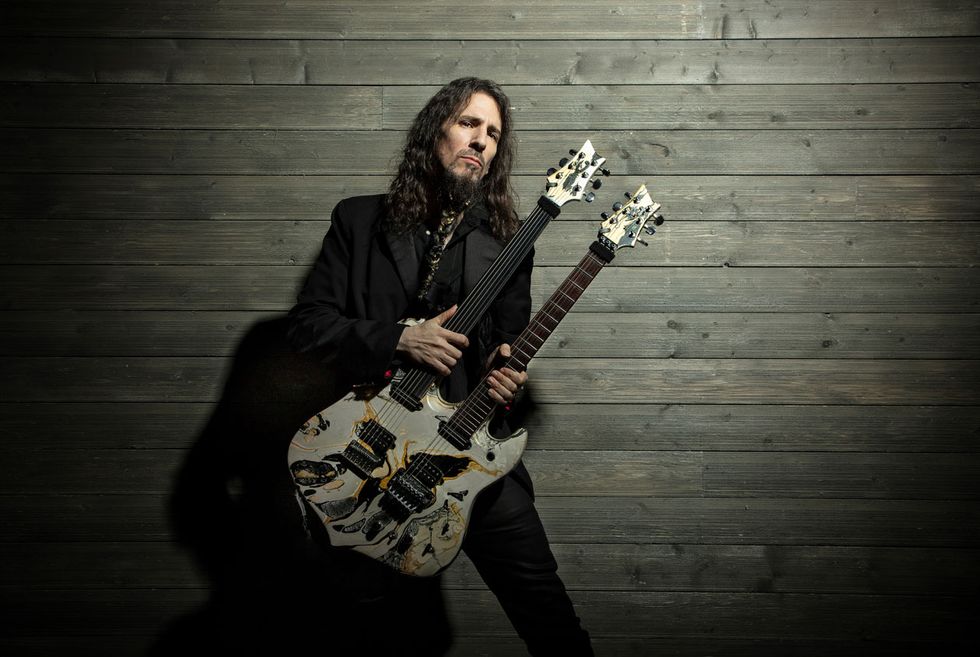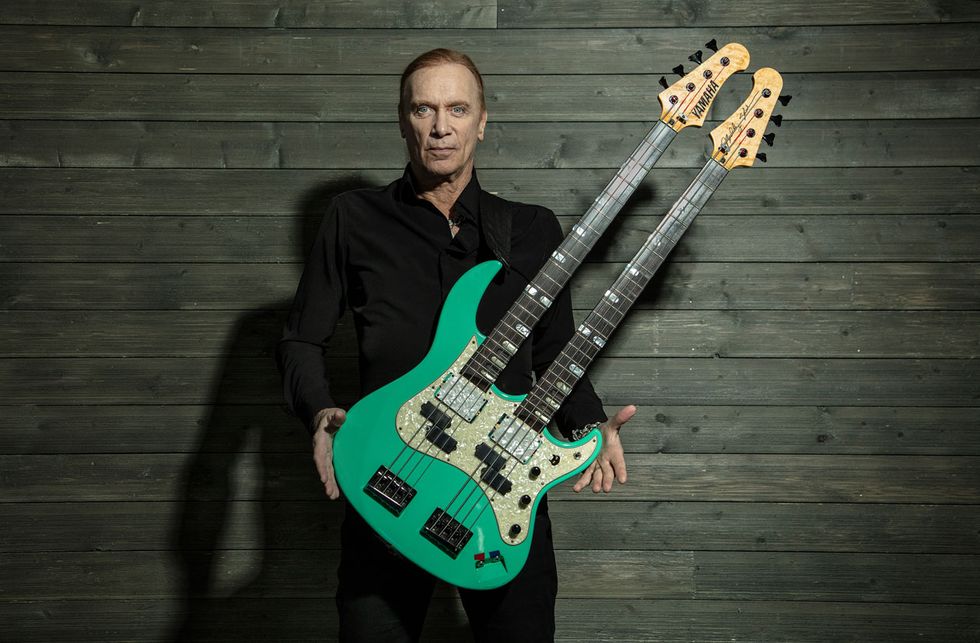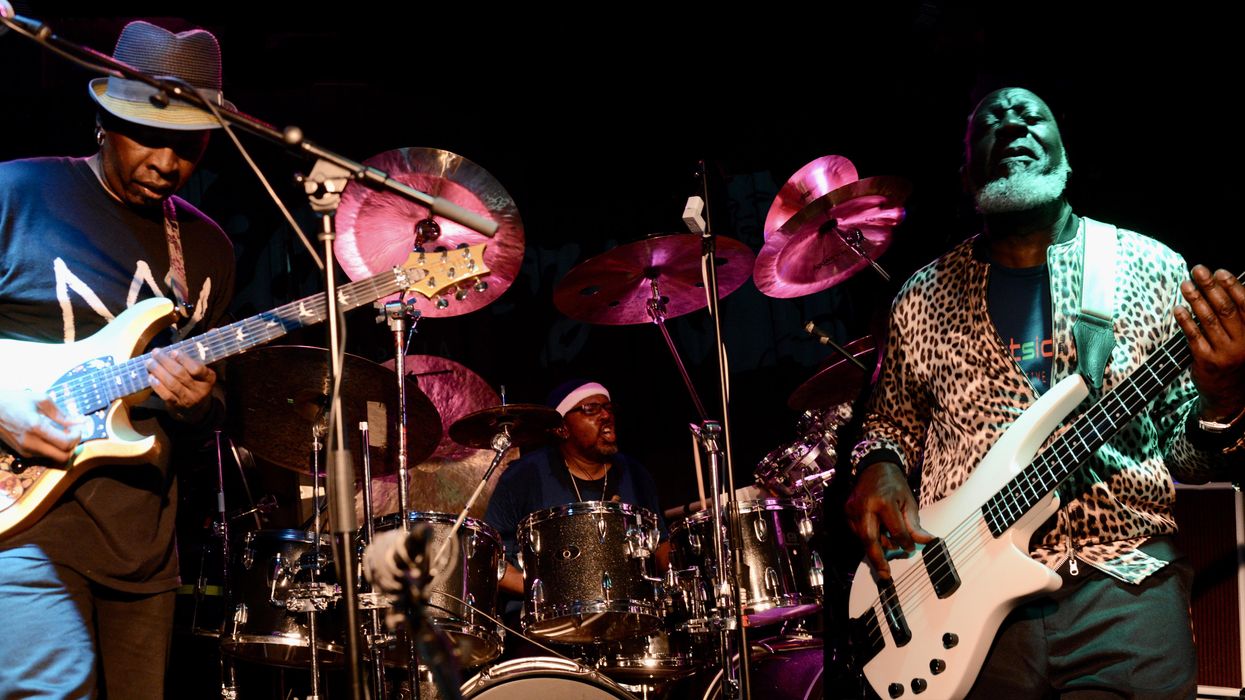In 2017, Ron “Bumblefoot” Thal and Billy Sheehan bowed to the inevitable and joined a supergroup. That wasn’t a first for either of them, but after decades of NAMM showcases, all-star house bands, prog cruises, guest appearances, overlapping careers, and bumping into each other, Bumblefoot and Sheehan were finally playing in a supergroup together. They teamed up with Dream Theater alumni Mike Portnoy (drums) and Derek Sherinian (keys), plus vocalist Jeff Scott Soto, and formed Sons of Apollo.
“Everybody knew each other,” Bumblefoot says. “About five years ago, me, Mike, Billy, and Derek played together on Progressive Nation at Sea, which was a music cruise. After we finished playing and jamming, Derek said, ‘Hey, we should form a band.’ A few years later, I got an email from Mike. He said, ‘You know how me and you always talked about putting a band together…?’ [Laughs.]
It’s easy to see why they wanted to work together. In addition to their decades of experience, stellar reputations, insane chops, and seemingly effortless ability to play anything—and despite their grueling schedules and myriad commitments—Bumblefoot, Sheehan, and company have similar tastes, experiences, sensibilities, and synergy that, at times, borders on mind-reading.
“You get that automatic ESP,” Sheehan says about his supernatural connection to Portnoy—although that may apply to the others as well. “Sometimes, Mike will do a move that’s new and unanticipated, and at the same time, I do the exact same move on the bass. We don’t plan it, talk about it, or know about it, but we both spin around and look at each other. It’s like an ESP psychic phenomenon. ‘How in the world did that land in sync?’”
MMXX is Sons of Apollo’s second studio effort and follows last summer’s concerts at the Plovdiv Roman Amphitheater in Plovdiv, Bulgaria, where they were backed by a full choir and symphony orchestra. That grandeur continues on MMXX, and examples include the epic fanfare of “Goodbye Divinity,” the tight crunch on “Asphyxiation,” and the mind-boggling, odd-metered unison lines and solos on “Fall to Ascend.” The band is a supergroup, after all, and the album is brimming with super musicianship. But despite the bravado, the songs are melodic, singable, and often anthemic. Does it shred? Of course, but it’s tasteful, too.
“I try to be musical,” Bumblefoot says. “But every once in a while you want to step out and do something that’s cerebral—one of those things that the brain connects to more on a pattern level than a melody level. Every once in a while, the kitchen sink gets in there.”
We spoke with Bumblefoot and Sheehan a few weeks before rehearsals started for the Sons of Apollo winter tour. We discussed the creation of MMXX, their amp-free approach to recording, and their experiences working with classical musicians. We also talked about Bumblefoot’s recent outing as lead singer for Asia’s reunion, and why Sheehan will never stop playing “Shy Boy.”
How do you like being in a band with Jeff Scott Soto? You must remember him from when he was Yngwie Malmsteen’s lead singer.
Bumblefoot: Oh, hell yeah … those first two Yngwie albums. Of course, Yngwie was phenomenal, but it was Jeff’s vocals that did it. If not for Jeff—I’ll just leave it at that—if not for Jeff…. He made the songs great. He made it more than just instrumental shred. He made it songs. He does the same with us. On top of that, every nightmare you’ve ever had with a singer, Jeff is the opposite. He’s like a godsend. He’s the greatest guy to be in a band with. He’s the guy that helps balance the tour budget and you can count on him every night—consistent, the easiest guy, and the most fun guy to get along with. He’s the opposite of every singer story that you’ll ever hear.
Billy Sheehan: I remember Jeff from many ages ago. Talas opened up for Yngwie on tour in the summer of 1985. That was a momentous tour, because before we did our first show I had a meeting with David Lee Roth and agreed to start a band with him, even though I was starting the Talas tour the next day. I had to keep it secret. For the whole tour, I couldn’t tell anybody that at the end of the tour I was going to be flying to L.A. It was quite an amazing thing.
When I found out I was doing this interview, I pulled out my copy of Talas’ Live Speed on Ice.
Sheehan: We just got that version of Talas back together. It looks like we’re going to get a record deal to record the stuff we never recorded. That will be pretty cool. We’ve done some shows. The band sounds the same. The drummer, Mark Miller, is unreal. The singer, Phil Naro, sings in as high a range and as righteous as ever.
How did Sons of Apollo come together?
Sheehan: I was playing with Mike in the Winery Dogs, with Richie Kotzen—a band that I absolutely love and cherish—and Mike wanted to do another project with Derek. I’ve also worked with Derek on a couple of his solo records. They chose Jeff Scott Soto as the singer. But the cherry on the cake was Ron “Bumblefoot” Thal. I jammed with him a couple of times in L.A. He always knew a bunch of Talas songs. It’s funny, a lot of guys from the New York area [know about Talas], we played down there a lot. Even Mike Portnoy. There’s a photo of his first rehearsal with Dream Theater, and he’s wearing a Talas shirt, so we made our impact back in the day. It’s quite a difference playing in a three-piece band and a five-piece band. I pull back a lot. I let the other guys have their spot. It’s an interesting discipline.
Bumblefoot: The songwriting started off as an email thread between me, Mike, and Derek—and this is for both records, really. I would come up with a guitar riff or song idea and send it to them. Derek would do the same. We had this whole bunch of ideas that we could build on when we all got together. For the first record, the three of us were in the studio for the first half, and then Billy got off tour and joined us. We took ideas or came up with a spontaneous idea on the spot, and by the end of the day it would evolve into an entire song. There would always be something different. Then Jeff got off tour, heard all the music, started putting melodies and words to it all, and turned our chaos into singable songs.

TIDBIT: The guitars and basses on the band’s second album were recorded without amps. Thal played through an IK Multimedia AmpliTube or a Line 6 Helix Native, and Sheehan used the Helix and an Ashly Audio compressor.
But the new album was not done like that.
Bumblefoot: No, unfortunately. Time was not on our side. What we did was me, Derek, and Mike got together at Mike’s house for eight days, took all our ideas, and instead of doing the final album recording of it, we made demos. We did a home recording version of everything, and then Mike went into the studio and laid his drums at the same place [Ocean Studios Burbank] we did the first album. They sent me the drum tracks, I laid guitars down to his drum tracks at my place, and Derek laid his parts at his place. We had our demo tracks from the stuff that we did at Mike’s house as a reference.
Sheehan: They got the writing together and sent out the tracks to me, once they were at a greater level of completion. When I record, I’m usually in the control room anyway. So it was very much like recording with the band. When I’m in the control room and just recording to tracks, the advantage is I can really put everything under a microscope, hear exactly what’s going on, and really line things up. Again, this is five guys playing a lot of complicated stuff, and it’s got to be righteous. It’s got to be right on or nothing.
What setup do you use to record with at home?
Bumblefoot: This will piss off the purists: my guitar, plugged into my computer, and either an IK Multimedia AmpliTube or a Line 6 Helix Native.
No amps and no mics?
Bumblefoot: Ampless.
Sheehan: It was all direct. I used the Helix and an Ashly Audio compressor. The Helix has been glorious for doing tracks. If somebody calls me, I grab it, put it in the car, get there, and get everything we need—it’s really been wonderful. I often record sitting in the control room, so I’m used to what it sounds like, whether it’s an amp out there, or I’m going direct. Sometimes in a session, I’ll plug right into the console, add a little EQ, possibly a touch of compression, and play like that—depending on the session, of course. For Sons of Apollo, we needed a really grindy, pounding, frightening bass tone. I’m really pleased with the way it came out.
Bumblefoot: I’ve been a Line 6 guy for 20 years, since the POD 2.0. When you find the right impulse responses to make it feel like you’re moving air, you can really get some nice stuff happening. And with the kind of touring I do, which is so diverse—one day I’ll be doing a guitar clinic, the next day I might be playing at a big festival with a band, the day after that might be an acoustic show, or some kind of one-man storytelling evening—it’s great having all your sounds there.
Although both Ron “Bumblefoot” Thal, here with one of his fleet of Viger DoubleBfoots, and Billy Sheehan play signature doubleneck instruments, it’s more than a novelty. Both players draw upon a wealth of tones and extended techniques with their axes. Photo by Hristo Shindov
Have the five of you played these new songs together in the same room as a band yet?
Sheehan: No, but I’m ready to go. A lot of times, when I have to record separately, and record to a track that’s already laid down, my goal is to play as much of it as possible from beginning to end, as opposed to doing it measure-by-measure, bar-by-bar, or part-by-part. I like to take it from the beginning and see how far we get. Generally, I can get through a lot of the song like that. It feels more like real life to me. Doing my homework is essential and I hit it hard. I always want to come in knowing everything I possibly can about the track, and be able to perform it as much as possible in hopefully one shot. That’s not always the case, of course, but that’s the goal and it helps to do that. That was a big help on this record.
Bumblefoot: The best performances happen when everyone is playing together and you’re locking into the overall pocket of things. With that, you’re forced to commit to things, which is good and bad. It’s great, because honesty comes from first takes, but it also doesn’t give you a chance to develop a song. It could be good, because, “This is what our instincts said, and we ran with it.” But it could be bad, because, “This is what our instincts said, and we ran with it.” [Laughs.] I guess the best thing would be the old school way of the band writing together, playing the stuff together, letting the songs develop, and then recording them after you’ve really connected with the song as a band, and let it tweak itself a little bit over time. But time is the enemy.
You play a lot of your rhythm guitar parts on the fretless. Why is that? Is that just where you are when writing the parts?
Bumblefoot: On the fretless, I drop the 6th string, the low E, two-and-a-half-steps down to a low B, almost like the 7th string on a 7-string. On the fretted, I drop the 6th string a whole-step down to D. I have two different tunings at the bottom. With the fretless, you can get some interesting, dragging, low, growly things. The fretless can lead you into different riffs that you wouldn’t necessarily come up with on the fretted. It’s not just a gimmick. It’s half my playing.
I would think the intonation, when playing rhythm, would be more important than when soloing. Do you have tricks for nailing the pitch?
Bumblefoot: Practice [laughs]. That’s it. You’ve got to practice the instrument and develop your intonation from what you hear, feel, and see—and triangulate all of that. Put it together and, hopefully, playing from those three angles, you’ll get in the ballpark.
Sheehan: His intonation is great. I’ve listened to him very closely and he nails it. It’s not impossible, of course, as every violinist and cellist knows. You listen to a proper classical musician, that’s their stock in trade. They hit that note and it’s the right note. He seems to have that. It’s a cool tonality, too, because it’s metal on metal—a metal fretboard with a metal string. He’s a really unique and incredible player. He has characteristics and flavors that are different from anybody I know, and it’s really wonderful to hear that.

Guitars
Vigier DoubleBfoot fretless/fretted doubleneck
Amps
IK Multimedia AmpliTube (studio)
Line 6 Helix Native (studio)
Line 6 Helix Floor (tour)
Engl Invader 2 100-watt head with 4x12 cabinet
Effects
Morley Wah
TC Electronic Sub ’N’ Up
TC Electronic Flashback Delay
TC Electronic Corona Chorus
TC Electronic Vortex Flanger
TC Electronic Hall of Fame Reverb
Strings and Picks
D’Addario NYXL (.009–.046, fretted neck; .012–.056, fretless)
Sinister picks .6 mm

Basses
Yamaha Attitude Double Neck (B–E–A–D on top: E–A–D–G on the bottom)
Yamaha Attitude Limited 3 long scale (B–E–A–D)
Yamaha Attitude Bass
Amps
Hartke LH1000 head
Line 6 Helix
Hartke HD cabinets
Effects
EBS Billy Sheehan Signature Drive
Suncoast BC2 Pearce Bass Preamp
Strings
Rotosound (.043–.110)
Speaking of classical musicians, what was it like playing with an orchestra?
Bumblefoot: The orchestra was great. It was so fucking cool seeing how the conductor and arranger came up with his ideas for what would work, hearing the orchestra play them, and having a choir as well. Playing “Diary of a Madman” with an orchestra and choir behind you at this big ancient amphitheater … that was nice. I should choose a better word than nice. That was definitely a moment to remember.
Sheehan: That was amazing. We got to play with real musicians. When the cellists arrived, I said, “The real musicians are here.” [Laughs.] It’s such an incredible discipline. But it’s funny, because I’ve seen classical players who can’t play if they don’t have that sheet music or that software directing them. They are a little bit lost. Whereas when I do have the sheet music there, I’m really lost. It’s an interesting dichotomy. Ideally, it would be great to do both, and there are players that do both so incredibly well, and I’m completely jealous of them.
As a band, and as you get used to each other, do you loosen up the forms and improvise?
Sheehan: We make room to move. It’s the nature of how I play. I do like the discipline of making sure I do it exactly the same way every time, exactly how it was on the record. That is a cool discipline. But generally, I’m a more improvisational player. I’ll hit the things I have to hit, but I’ll move around, too. If you really know the song well, there’s room to move. And “move” doesn’t necessarily mean more notes. It just means different melodic and harmonic moves that will take the song into different places and make it come alive.
I remember my first days of hearing live records. One of the first ones I ever heard was “I’m a Man” by the Yardbirds, on Having a Rave Up with the Yardbirds. “I’m a Man” is a very simple song, but when you heard the live version, they went crazy with it, and it was amazing. I realized “Wow, a live version, this is what you do.” That was back in the mid 60s. And, of course, hearing Hendrix live. What he did with songs you knew and loved became part of my constitution—to understand that when you play it live you have some freedom to move around. Not completely. I don’t want to make the thing unrecognizable. You want to stick with the fundamentals, and it doesn’t apply to every song or every situation. But especially in a more jammy, improvisational, wilder situation instrumentally, it’s fun to be able to move around.
Bumblefoot: Solo-wise, I try, just for the challenge of it, to keep it similar to what I did on the album, which is what I did when we toured the first album. A lot of those solos happen as you play. You improvise until you do something shitty, and then take it from there and continue. Learning something that just flowed out is tough, but I like the challenge. That’s the problem I have: Most of my solos just happen and then I have to figure out what the hell I did—to get comfortable doing something night-after-night that just happened once as an automatic, almost, reflex. So that’s the tough part: learning your own shit. Also, Derek and I can definitely infiltrate each other’s sonic space, so it’s important to work out who’s doing what part and with what kind of sound. Sometimes, you want it to double up. The thing about Derek is he plays like a guitar player. He runs his keyboards through half stacks, guitar amps. He plays with a lot of grit, and it’s like playing with a second guitarist. Sometimes you want to be in unison with each other and sometimes you want to contrast each other. Depending on the song, and depending on the part, we work it all out. Sometimes I’ll be the layer on top. Sometimes, he’ll be.
You recently toured with a reunited Asia. What was it like being a lead singer? Did you feel naked without a guitar?
Bumblefoot: I feel liberated. I’m suddenly 20 pounds lighter without the doubleneck. I think I’m actually taller. It was a lot of fun.
Billy Sheehan began using his Yamaha Custom Shop-built doubleneck Attitude basses in 1996, on Mr. Big’s Hey Man tour. It weighs about 20 pounds and has a toggle to choose either or both necks, plus two outputs, which means each gets its own wireless transmitter in live performance. Photo by Hristo Shindov
Steve Howe joined as well. Did you learn any cool things from him about guitar playing?
Bumblefoot: It was all the surviving original members of that band. Carl Palmer on drums. Geoff Downes on keys. Steve Howe for the last half of the show would come out—that’s when I would take off my guitar and be Wayne Newton with the mic—on bass, Billy Sherwood. I play guitar and sing for the first half and then just sing for the second half. I’ve been a Yes fan and an Asia fan from way back. I heard the Going for the One album [by Yes] when it came out when I was 7 years old. I still think that’s one of the greatest masterpieces ever made. What I found interesting was that Steve Howe also uses the Helix. He uses the Helix into the Line 6 flat response cabinets—almost like floor monitor speakers. But he had his rack of all those legendary guitars that he’s used, and just seeing them up close was like, yeah, damn.
Billy, going back to that ’85 tour with Talas, did you know David Lee Roth was going to do your song “Shy Boy?”
Sheehan: I’ve done that song in just about every band I’ve played in [laughs]. I did it with David Lee Roth, we do it when I play it with Steve Vai solo, Mr. Big did it. I’m very pleased that people still request it and want to hear it. But I don’t want to overdo it, so I try to mete it out sparingly. There are a lot of guitar players who want to do it with me because they want to play the Steve parts along with me. It’s a cool situation to have a song that’s been around for a long time and have people still enjoy it. I’m supremely grateful that they do and that they still ask for it.
Sons of Apollo play “Labyrinth,” from their debut, Psychotic Symphony, at their memorable 2018 concert in the Roman amphitheater in Plovdiv, Bulgaria. Check out the frenetic interplay between Bumblefoot, Billy Sheehan, and Derek Sherinian starting at about 5:50.

















![Rig Rundown: Russian Circles’ Mike Sullivan [2025]](https://www.premierguitar.com/media-library/youtube.jpg?id=62303631&width=1245&height=700&quality=70&coordinates=0%2C0%2C0%2C0)
















![Rig Rundown: AFI [2025]](https://www.premierguitar.com/media-library/youtube.jpg?id=62064741&width=1245&height=700&quality=70&coordinates=0%2C0%2C0%2C0)




















 Zach loves his Sovtek Mig 60 head, which he plays through a cab he built himself at a pipe-organ shop in Denver. Every glue joint is lined with thin leather for maximum air tightness, and it’s stocked with Celestion G12M Greenback speakers.
Zach loves his Sovtek Mig 60 head, which he plays through a cab he built himself at a pipe-organ shop in Denver. Every glue joint is lined with thin leather for maximum air tightness, and it’s stocked with Celestion G12M Greenback speakers.






